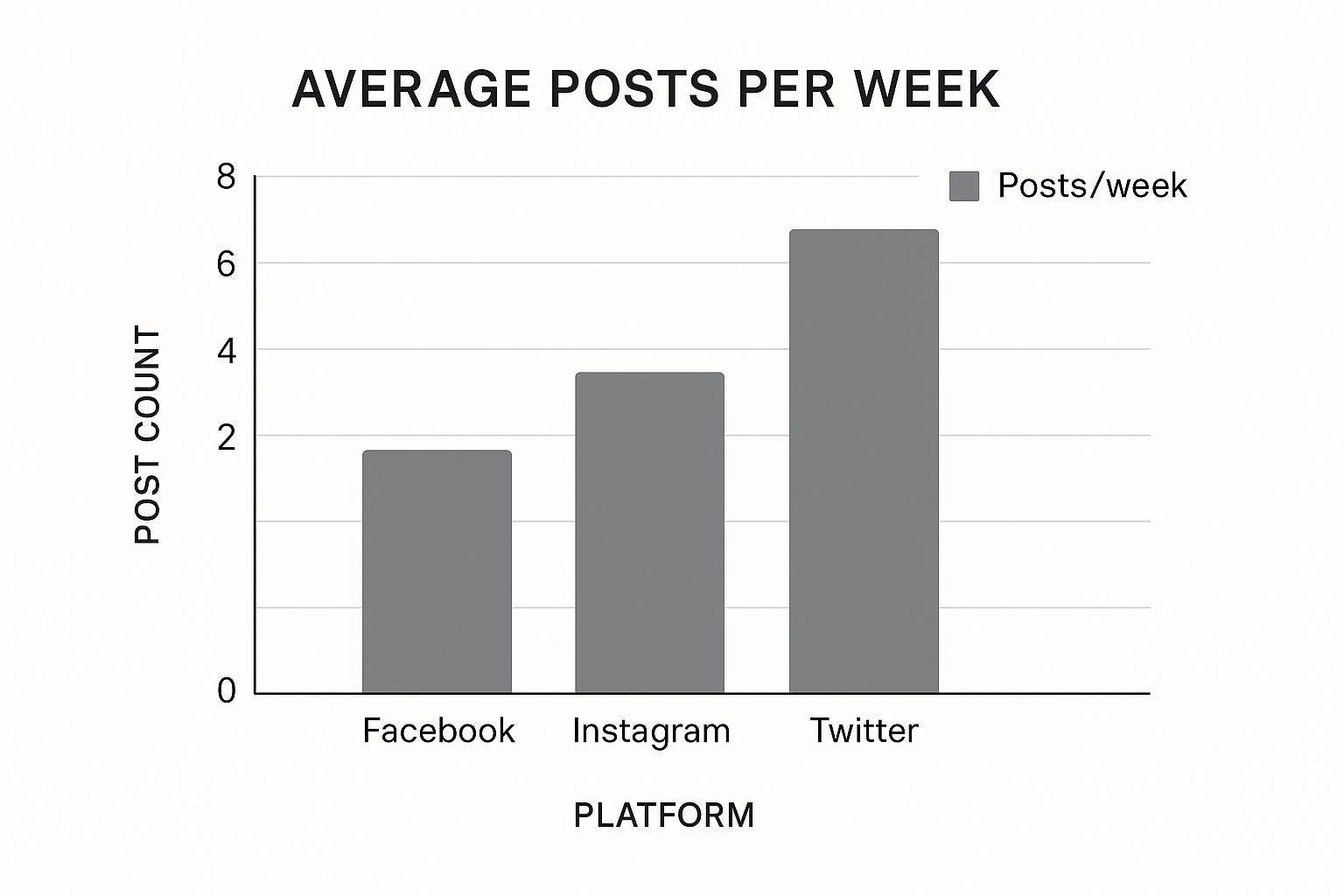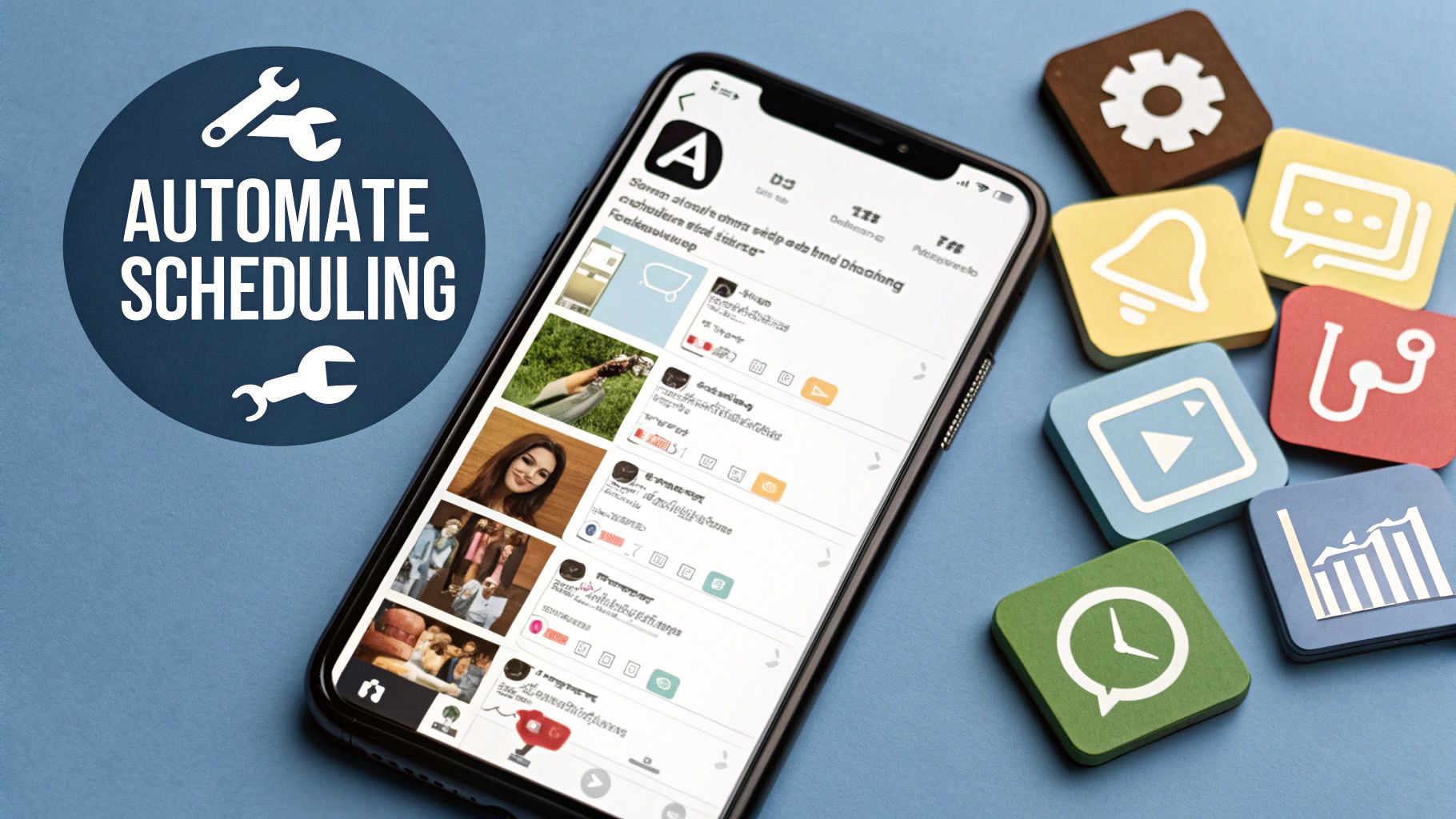Why Smart Brands Rely on Content Calendars

In the fast-paced world of social media, simply posting isn’t enough. Successful social media accounts thrive on strategic communication, not reactive posts. A social media content calendar forms the foundation of this strategy. It transforms the chaos of last-minute posting into a streamlined process for creating engaging content. This allows brands to maintain a consistent voice across multiple platforms, tailoring their message to each platform’s specific audience without losing their core brand identity.
Imagine a brand juggling various social media platforms without a calendar. They risk missed opportunities to engage their audience, inconsistent posting schedules, and difficulty aligning their messaging with business objectives. A content calendar addresses these challenges by providing a structured plan. This not only helps organize future content but also frees up time for spontaneous engagement and real-time interaction, crucial for building genuine connections with followers.
Furthermore, a social media content calendar strengthens the link between marketing efforts and overall business goals. Planning content in advance ensures that posts support specific campaigns, product launches, or seasonal promotions. This strategic alignment maximizes the impact of every post, transforming social media into a driver of business results. This proactive approach allows for carefully crafted messaging that resonates with the target audience on each platform.
This level of planning is essential in the ever-expanding social media landscape. Creating and implementing a social media content calendar requires understanding this digital environment. By 2025, there are projected to be 5.42 billion social media users globally, with the average person using approximately 6.83 different social networks. A well-designed content calendar can effectively reach this vast user base by aligning strategic campaigns with cultural moments, seasonal trends, and customer interests. For example, incorporating key dates like major holidays or niche celebrations can significantly boost engagement. Find more in-depth statistics here: Discover more insights about social media statistics
Benefits of a Social Media Content Calendar
- Consistency: Regular posting keeps your audience engaged and strengthens your brand presence.
- Strategic Alignment: Ensures your content supports your overall marketing and business objectives.
- Improved Time Management: Eliminates last-minute scrambling and allows for efficient content creation.
- Increased Engagement: Creates a framework for targeted content that resonates with your audience.
- Better Collaboration: Improves communication and coordination within marketing teams.
Key Components of an Effective Calendar
A well-structured social media content calendar should include these elements:
- Date and Time: When each post will be published.
- Platform: The intended social media channel for each post.
- Content Type: The format of the content (e.g., image, video, text).
- Topic/Theme: The subject matter of the post.
- Call to Action: The desired action for your audience to take.
- Assets: Links to any accompanying images, videos, or other materials.
By incorporating these components, your social media content calendar becomes a powerful tool for boosting engagement, achieving business goals, and navigating the complexities of the ever-changing social media world. It’s the foundation upon which successful social media strategies are built.
Building Your Calendar Framework That Actually Works
Establishing a thriving social media presence takes more than just posting occasionally. It requires a strategic and organized approach, and the foundation of this is a well-structured social media content calendar. This isn’t about rigidly scheduling every single post. Instead, it’s about creating a flexible framework that keeps your team organized and efficient while allowing room for adaptability.
Choosing the Right Organizational System
The first step is finding the right system for your team’s workflow. Options range from simple spreadsheets to advanced software. For smaller teams or individuals, a customized spreadsheet in Google Sheets can be perfectly adequate. This allows for easy tracking of important details such as posting dates, platforms, content types, and topics.
As your team and content volume expand, dedicated social media management platforms become increasingly beneficial. These platforms provide advanced features like collaboration tools, approval workflows, and analytics integration. EvergreenFeed is a good example, streamlining the scheduling of evergreen content across different platforms and freeing up time for strategic initiatives. For larger teams, project management platforms like Trello or Asana offer visual organization and robust collaboration features.
Essential Components of an Effective Calendar
No matter which system you choose, certain elements are essential for an effective social media content calendar. To give you a better idea of these, let’s look at a breakdown of each in a table format. This table highlights the core components, their purpose, and tips for implementing them within your calendar.
A well-structured content calendar is vital, but it shouldn’t stifle creativity or the ability to respond to current events. Think of your calendar as a roadmap, not a rigid itinerary.
| Component | Purpose | Implementation Tips |
|---|---|---|
| Content Categorization | Simplifies scheduling and analysis, allowing you to see patterns and trends. | Group similar content together (e.g., blog posts, promotions, product spotlights, user-generated content, behind-the-scenes glimpses). |
| Platform Designation | Ensures optimized formatting and targeting for each platform. | Clearly specify the intended platform for each piece of content. |
| Scheduled Posting Times | Maximizes visibility and engagement by aligning with audience activity. | Plan post times based on when your audience is most active. |
| Content Development Status | Ensures smooth execution by tracking progress. | Track each piece of content from ideation to creation, editing, and final approval. |
| Approval Workflows | Maintains brand consistency and prevents errors. | Implement a clear approval process, especially for larger teams. |
| Performance Metrics Tracking | Allows for data-driven optimization. | Integrate analytics tracking directly within the calendar if possible. |
This table, “Social Media Content Calendar Essential Components,” provides a comprehensive breakdown of the key elements needed in an effective social media content calendar. By incorporating these components, you can create a more organized and efficient workflow.
Balancing Structure with Adaptability
Build in buffer time for spontaneous posts related to trending topics or real-time events. For instance, if a significant industry event occurs, your calendar should be flexible enough to accommodate timely, relevant content.
Learning From Successful Brands
Many successful brands have mastered the art of combining structured planning with adaptability. They treat their social media content calendars as dynamic tools, regularly adjusting their strategies based on performance data and emerging trends. They understand that social media is constantly evolving, and their calendars reflect this.
This involves continually analyzing performance metrics and adapting your content calendar accordingly. By examining the best practices of leading brands, you can gain valuable insights for building a calendar framework that effectively serves your team’s needs.
Building Your Own Social Media Content Calendar in Google Sheets (Example)
Creating a basic yet functional social media content calendar using Google Sheets is surprisingly simple. Below is a sample structure to get you started:
| Date | Time | Platform | Content Type | Topic/Theme | Call to Action | Status | Notes |
|---|---|---|---|---|---|---|---|
| 2024-11-15 | 10:00 AM | Text | New Blog Post | Read More | Scheduled | Link to blog post included in assets folder | |
| 2024-11-15 | 2:00 PM | Image | Product Spotlight | Shop Now | In Progress | Image needs final approval | |
| 2024-11-16 | 9:00 AM | Video | Customer Testimonial | Visit Website | Completed | Ready to upload | |
| 2024-11-17 | 11:00 AM | Article | Industry Insights | Learn More | Draft | Needs further editing |
By implementing these strategies and adapting your calendar to your specific requirements, you can shift your social media presence from reactive to proactive, driving meaningful results. Remember, a well-crafted social media content calendar is a living document that continually evolves to meet the demands of the ever-changing social media world.
Strategic Planning That Drives Meaningful Engagement

A social media content calendar is more than just a scheduling tool. It’s a strategic roadmap designed to guide your interactions with your audience and foster meaningful connections. This involves understanding your audience, pinpointing significant moments, and crafting content that truly resonates. It’s about moving beyond simply filling calendar slots and focusing on the strategic purpose behind every post.
Identifying Key Moments That Matter
A successful social media strategy hinges on identifying key moments relevant to your target audience. Consider industry events, seasonal trends, or national holidays that align with your brand and resonate with your followers. By connecting your content to these moments, you demonstrate relevance and increase the chances of engagement. This could involve developing themed content for a particular holiday or joining trending conversations during a major industry conference.
Also, consider developing thematic content series to build anticipation and a sense of community among your followers. These series can take various forms, such as weekly tips, behind-the-scenes glimpses of your company, or spotlights featuring user-generated content. Think of it like a weekly TV show – creating anticipation keeps your audience returning for more.
Data-Driven Approaches to Optimal Posting
A data-driven approach is vital for optimizing posting frequency and timing. Analyzing past performance and understanding platform-specific algorithms are essential for maximizing reach and engagement. Tools like EvergreenFeed can help automate these processes, ensuring a consistent flow of evergreen content while freeing up your time for strategic initiatives. For instance, if your audience is most active on Instagram on weekday evenings, schedule your posts accordingly to capitalize on these peak engagement times. This strategic planning helps ensure your content is not only seen but also sparks meaningful interaction.
Effective engagement is crucial for any successful social media content calendar. In 2025, average social media engagement rates are expected to fall between 1.4% and 2.8%, depending on the industry. A well-planned calendar prioritizes boosting these rates through resonant content. Learn more about these statistics: Find more detailed statistics here. Creating engaging posts, stories, or live streams around important events or campaigns is key. For example, aligning content with current seasonal trends can greatly increase user interaction.
Balancing Promotional Content with Value-Driven Posts
While promoting your products or services is important, finding the right balance between promotional and value-driven content is critical. Overly promotional content can feel intrusive and alienate followers. Instead, focus on providing genuine value through informative, entertaining, or inspiring posts. This builds trust and strengthens your relationship with your audience, making them more receptive to promotional messages when they do appear. Consider sharing helpful tips, behind-the-scenes glimpses into your company culture, or user-generated content showcasing your brand’s community.
Implementing Practical Techniques
Putting these techniques into action doesn’t require a large team or extensive resources. Even small businesses and individual creators can effectively use a social media content calendar to achieve meaningful results. Start by defining your target audience and their interests. Then, identify key moments relevant to your brand. Finally, create a mix of promotional and value-driven content that resonates with your audience. This strategic approach, coupled with a well-structured content calendar, paves the way for meaningful engagement and sustainable growth on social media. Remember, it’s not just about posting more; it’s about posting smarter.
Platform-Specific Strategies That Maximize Impact

This bar chart illustrates the average recommended posting frequency per week across three key platforms: Facebook, Instagram, and Twitter. The data shows that Twitter thrives on frequent interaction, with a suggested average of seven posts per week. In contrast, Facebook recommends an average of just three posts per week. This difference underscores the importance of a social media content calendar designed for each platform’s specific rhythm.
Creating native content—content specifically designed for a particular platform—is essential for achieving optimal results. For example, Instagram’s visually oriented users respond positively to high-quality images and engaging Reels. Meanwhile, Twitter users appreciate concise, text-based updates and breaking news. Grasping these subtle differences is critical for planning platform-specific content types and integrating them effectively into your overall content strategy.
Tailoring Content to Each Platform
This doesn’t mean sacrificing your brand’s consistency. Rather, it’s about adapting your core message to resonate with the unique expectations of each platform’s audience. It’s similar to speaking multiple languages fluently: the underlying message remains the same, but the expression adapts to the specific context. This targeted strategy ensures your content feels authentic and engaging across every platform.
To illustrate, let’s explore how to effectively tailor your content for different platforms:
- Instagram: Emphasize visually compelling content, such as high-quality images, short videos, and Stories. Leverage relevant hashtags and actively engage with your audience through comments and direct messages.
- Facebook: Distribute a balanced mix of text, image, and video content. Foster community interaction by posing questions and responding to comments.
- Twitter: Focus on succinct, text-based updates, breaking news, and engaging in real-time conversations using pertinent hashtags.
- LinkedIn: Share insightful articles, industry news, and career-related updates. Participate in professional discussions and connect with other users.
This adaptive approach allows you to capitalize on the strengths of each network while preserving a consistent brand identity across the board.
To better understand how to strategize content for different platforms, take a look at the comparison table below. It summarizes the optimal content approaches for each platform.
Platform-Specific Content Strategy Comparison
Comparison of optimal content approaches across major social media platforms
| Platform | Best Content Types | Posting Frequency | Audience Expectations |
|---|---|---|---|
| High-quality images, short videos, Stories | 1-2 times per day | Visually appealing content, engagement, community interaction | |
| Mix of text, images, and videos | 1-2 times per day | Community interaction, diverse content, brand updates | |
| Concise text updates, breaking news, real-time conversations | Multiple times per day | Up-to-the-minute information, engagement, concise messaging | |
| Thought leadership articles, industry news, career updates | 1-2 times per day | Professional content, industry insights, networking opportunities |
This table provides a concise overview of how to best approach content creation for each platform. By tailoring your content to these specific expectations, you’ll dramatically improve engagement and reach.
Efficient Content Repurposing
Developing fresh content for every platform can be a demanding task. This is where content repurposing offers significant value. A single blog post, for example, can be transformed into a series of tweets, Instagram captions, or even short video clips for TikTok. Understanding which digital marketing attribution models yield the best results is essential for this process. This strategy maximizes the reach of your content without requiring you to constantly start from scratch. However, remember that repurposed content must be adapted to suit each platform’s unique format. A long-form blog post won’t translate effectively into a tweet, just as an Instagram caption might not resonate on LinkedIn.
Building a Recognizable Cross-Platform Presence
By understanding the specific characteristics of each platform, you can create a social media content calendar that drives optimal impact. Tools like EvergreenFeed can streamline this process further by automating the distribution of evergreen content across multiple platforms, allowing you to focus on more strategic initiatives. This integrated approach empowers you to build a strong and recognizable brand presence across platforms, strengthening your brand and engaging your audience where they are most active. Remember, prioritize quality over quantity. Tailoring your strategy and optimizing your social media content calendar for each platform ensures that every post resonates with the right audience and contributes meaningfully to your overall marketing goals.
Timing Your Content For Maximum Relevance

A well-structured social media content calendar considers not only what to post, but also when. Timing is crucial for maximizing relevance and ensuring your message resonates with your audience. This involves strategic planning around key dates, understanding seasonal trends, and maintaining the flexibility to capitalize on unexpected opportunities. Imagine posting winter holiday-themed content in the middle of summer. It would feel out of place and disconnect with your audience’s current mindset.
Identifying Key Dates and Trends
Start by identifying key dates and trends relevant to your brand and target audience. This includes mainstream holidays, industry events, and even niche celebrations that resonate with your specific community. Google Trends and social media analytics platforms can help uncover these opportunities.
Additionally, explore relevant hashtags and monitor conversations within your niche to identify emerging trends and topics of interest. This proactive approach allows you to plan ahead and create timely content that aligns with current conversations and cultural moments.
Planning a social media content calendar strategically aligns marketing with key dates. In 2025, marketers have access to comprehensive guides and statistics highlighting important dates and trends. Using a social media holiday calendar lets marketers capitalize on events like major holidays and niche celebrations, enhancing content reach and relevance.
A well-crafted calendar keeps messaging consistent and aligned with broader cultural and seasonal themes. This aids planning and evaluates campaign impact by measuring post-launch engagement. Learn more about leveraging these calendars: Discover more insights about social media holiday calendars.
Building Thematic Content Around Seasonal Trends
Once you’ve identified relevant dates and trends, focus on building thematic content that goes beyond simple holiday greetings. Instead of relying on tired clichés, create engaging stories that connect with your audience emotionally.
For example, during the back-to-school season, share helpful tips for staying organized or highlight relevant products that ease the transition back into the classroom, rather than just wishing students good luck. This approach provides value to your audience while maintaining seasonal relevance.
Maintaining Flexibility For Unexpected Opportunities
While planning is essential, your social media content calendar should also be flexible enough to accommodate unexpected events and trending topics. Think of it as a roadmap that guides your content strategy while allowing for detours.
If a major industry event occurs unexpectedly, your calendar should allow you to incorporate relevant content without disrupting your overall strategy. This balance of planned content and adaptability is crucial for staying relevant in today’s fast-paced social media environment.
Creating a Year-Round Editorial Strategy
Developing a year-round editorial strategy provides a solid foundation for your social media content calendar. This strategy should outline key themes and topics you’ll focus on throughout the year. Consider dividing your calendar into quarters and assigning specific themes to each period.
This creates a cohesive content narrative that keeps your audience engaged throughout the year. Within each quarter, you can incorporate relevant key dates and seasonal trends, ensuring a balance of planned content and timely updates. This helps you stay organized and maintain a consistent brand presence without becoming predictable. Tools like EvergreenFeed further support this strategy by automating the distribution of evergreen content, freeing up time for crafting timely and engaging posts around key events.
Tools and Templates That Streamline Your Workflow
Creating a social media content calendar can feel daunting. However, using the right tools and templates can simplify the process. Choosing the best solution depends on factors like team size, budget, and desired features. This section explores effective solutions, from simple spreadsheets to robust platforms.
Free and Flexible: Spreadsheet Templates
For individuals or small teams with limited budgets, spreadsheet applications like Google Sheets offer surprising flexibility. They allow for basic content scheduling, tracking key details such as posting dates, times, platforms, and content types.
- Benefits: Free, accessible, easy to customize, and simple to share.
- Drawbacks: Lacks advanced features, can become disorganized with large volumes of content, and requires manual updates.
Here’s an example of a basic Google Sheet calendar:
| Date | Time | Platform | Content Type | Topic/Theme | Call to Action | Status |
|---|---|---|---|---|---|---|
| 2024-11-20 | 10:00 AM | Text | New Blog Post | Read More | Scheduled | |
| 2024-11-20 | 2:00 PM | Image | Product Spotlight | Shop Now | In Progress | |
| 2024-11-21 | 9:00 AM | Video | Customer Testimonial | Visit Website | Completed |
This is a great starting point. As your needs grow, more robust tools can further enhance your workflow.
Social Media Management Platforms
As content volume and team size increase, dedicated social media management platforms offer valuable features. Platforms like Buffer allow scheduling across various networks, provide analytics, and often include collaboration tools for team workflows. Hootsuite offers similar functionality, with options for managing multiple accounts and monitoring social media conversations. These tools help streamline posting, track performance, and improve team coordination.
Powering Up Evergreen Content with EvergreenFeed
Maintaining a consistent posting schedule is essential. Creating fresh content daily can be time-consuming. This is where EvergreenFeed excels. It integrates seamlessly with platforms like Buffer, automating the distribution of valuable evergreen content.
- Content Buckets: Organize content into thematic categories.
- Automated Scheduling: Set posting frequencies and let EvergreenFeed handle the rest.
- Time Savings: Free up time for creating engaging, timely content and focusing on strategic initiatives.
- Increased Reach: Maximize the impact of evergreen content by ensuring consistent visibility.
Imagine having a library of blog posts, quotes, and tips. With EvergreenFeed, you categorize these into buckets and set a schedule (e.g., three times a week). The platform automatically selects and posts content from those buckets, keeping social media channels consistently active.
Project Management Platforms for Complex Workflows
For complex campaigns involving multiple teams and content formats, project management software like Trello or Asana can become essential components of your social media content calendar strategy. These platforms provide visual organization, detailed task management, and robust collaboration features. They are particularly useful when managing content creation, approvals, and feedback within larger teams.
Choosing the Right Tool
The best tool for managing a social media content calendar aligns with specific workflow and goals. Start with free options like spreadsheets for solo creators or small teams. As needs expand, consider social media management platforms for increased functionality. For maximizing the reach of evergreen content, EvergreenFeed provides a powerful and efficient solution. It automates repetitive tasks and allows focus on strategic content creation.
Ready to automate evergreen content and reclaim valuable time? Sign up for a free EvergreenFeed account today: Start Automating Your Evergreen Content Now




